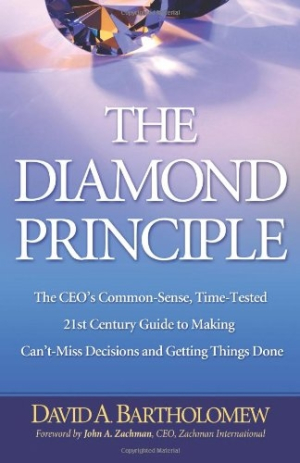The Diamond Principle
The CEO's Common-sense, Time-tested 21st Century Guide to Making Can't-miss Decisions and Getting Things Done
It has become common practice in business-related books to present a formula or action plan and to give it a clever name. In this respect, The Diamond Principle follows the pack. However, David A. Bartholomew’s book stands out because of his no-nonsense, straightforward approach to putting “The Diamond Principle” into practice and demonstrating its success.
Bartholomew, a business consultant and former chief information officer, developed his model using the diamond of a baseball field as his inspiration. He assessed how ball players work together to become a winning team and applied this thinking to the business world. Bartholomew says the principle has been tested by more than fifty companies “where there was a gap between executive management expectations and the results achieved from an effort undertaken by the company and approved by these executives.”
In simple language and without a lot of extraneous material, Bartholomew explains the five rules of The Diamond Principle and advises executives on how to implement each. For example, in Rule #1, “Prioritize and Collaborate Across Organization Silos,” the author writes: “Simply put, a company should have only one #1 priority, one #2 priority, one #3 priority, and, in total, can typically manage no more than ten to twelve priority efforts at a time, including corporate and business unit priorities.” Beyond the rules, Bartholomew employs vivid exercises that executives will remember, including The Chalk Talk (a facilitated discussion by senior executives) and The Three-Legged Stool Theory (listen and learn, take action, and give back to your customer).
Bartholomew also sets forth a Technology Action Planning process that includes five specific activities to develop a plan for implementing technology in any organization. While this process is clearly derived from the author’s IT background and therefore most appropriate for assessing technology, the concept is useful as a general business tool. The chapter that addresses what the author calls the “seven myths about technology investments” will do much to help CEOs avoid the trap of getting bogged down by technology, a struggle many companies currently face.
The author closes the book with a group of success stories detailing how The Diamond Principle has enhanced the ability of companies to achieve various kinds of success. While most of the stories are drawn from the financial services industry, they all offer compelling examples that could apply to any type of business.
Despite the obligatory sales pitch at the very end of the book, The Diamond Principle offers a succinct presentation of each concept, specific steps for its implementation, and examples of success stories. This book should be of value to CEOs and senior executives alike.
Reviewed by
Barry Silverstein
Disclosure: This article is not an endorsement, but a review. The publisher of this book provided free copies of the book and paid a small fee to have their book reviewed by a professional reviewer. Foreword Reviews and Clarion Reviews make no guarantee that the publisher will receive a positive review. Foreword Magazine, Inc. is disclosing this in accordance with the Federal Trade Commission’s 16 CFR, Part 255.

